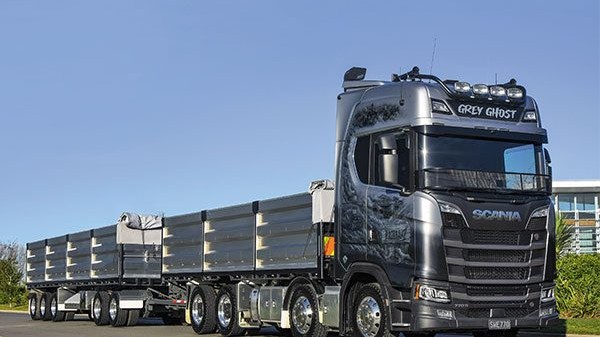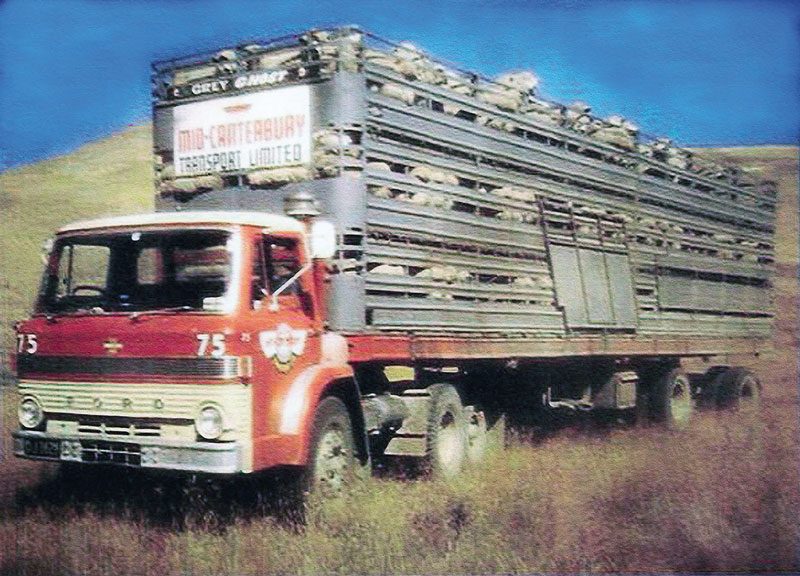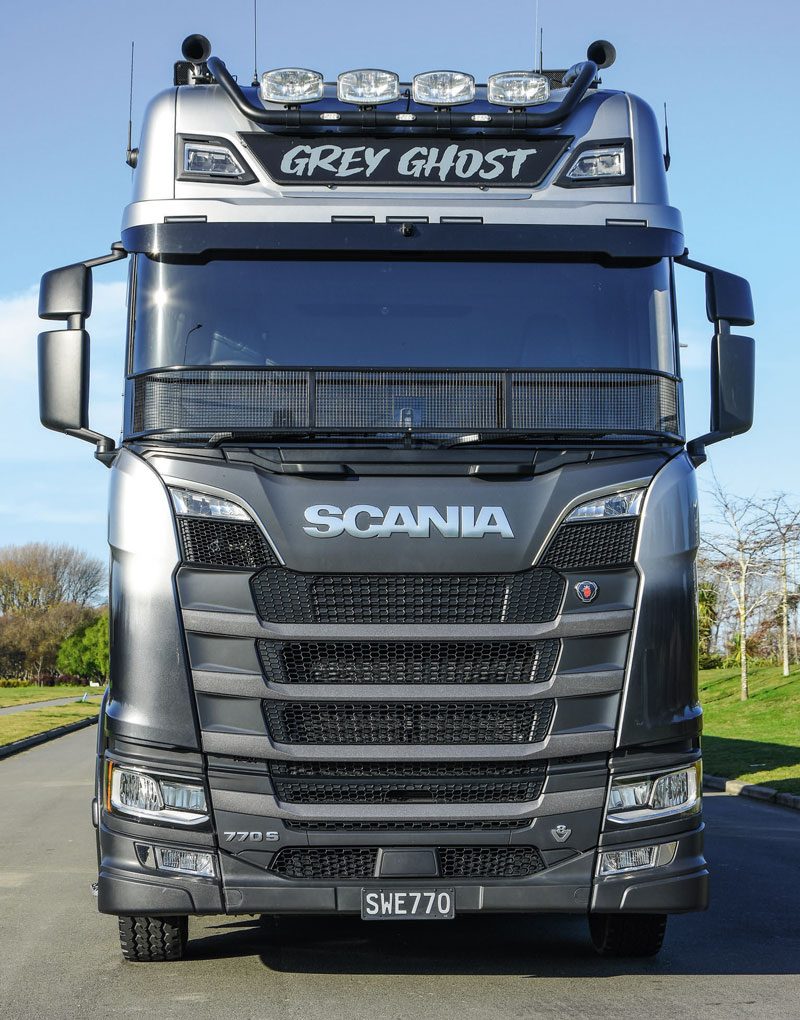
It’s not uncommon to see names on trucks, personalised and often accompanied by an image. Sometimes humorous, of a personal nature or a family name, the true meaning is potentially lost to onlookers and only fully appreciated by the person who named the truck. But its significance is no less important.
I initially met Gerard Daldry of Protranz on a cold, gloomy King’s Birthday Weekend. The big 770S Scania was on its maiden trip home to Christchurch from Invercargill, having stopped briefly to take in the Gore Truck Show, where, unsurprisingly, it came away with the Best Paint trophy.
Breaking cover at last year’s TMC Trucking Industry show in Christchurch as cab and chassis, the Scania promised to be something special by stepping away from Protranz’s usual colour scheme. Instead, it sported an impressive paint job with Grey Ghost proudly air-brushed between the factory roof spotlights in tones of grey and satin black and with grey covers.
On a colourless day, the name seemed hugely appropriate, with the only obvious colour coming from the over-width placards on the front of the truck. Further inspection revealed impressive artwork adjoining the base greys. Even on a gloomy day, the Scania is impressive, subtle and understated. Devoid of the flashy bolt-on extras common these days, the blacked-out air horns, roof-mounted spotlight bar and stoneguard keep the mood broody.

Twin black aftermarket air ram intakes hint there’s still more to the truck than meets the eye. That story also follows Gerard’s ‘thinking outside the box’ philosophy, the Scania featuring the DC16 Euro-6 V8 engine rated at 574kW (770hp) and 3700Nm (2729lb/ft).
Transport Engineering Southland built the truck deck and trailer, with in-house engineering at Protranz readying the cab and chassis for deck fitment and additional engineering. Set up as a lift-out side-tipper, it will cart drainage pipes, building and rural materials and bulk supplies. It’ll also do stock cartage duties. Protranz built a stock deck for when crates are fitted, and it stretched an existing trailer from four to five axles for the job.
The images airbrushed into the cab suggested there was much more to the meaning behind Grey Ghost than the colour. To fully appreciate the name requires stepping back some 50 years to Gerard’s childhood.
He grew up in rural Rakaia, obsessed with trucks and heavily influenced by the drivers, their skills and their work ethic. As he fondly recalls that era’s fleet numbers and drivers, it’s obvious how positive influences on a young mind last a lifetime: Johnny Kerr, Brian Heany, Johnny Johnson…
”It takes a village to raise a child,” Gerard reflects, adding these drivers were formative in the local community, and as a young boy, he looked up to them. “Their jobs, dedication and they drove trucks – and that was just damn cool!”
Johnny Johnson lived down the road from the Daldry family home and drove a 3070 International truck and trailer stock unit for Burnetts Transport. A young Gerard would phone Johnny and ask what he and his truck were doing the following day. “I was probably the biggest nuisance ever,” he laughs, adding he was often turned down. But an eager Gerard knew Johnny started work at about 6.30am and would listen for the sound of the engine, watch for the headlights, head down the driveway, cross the road and wait for the truck.
“He probably thought ‘for f”*k sake!’ but the truck would stop, let me in, and take me for a ride.”
Later in life, Gerard found that same truck and rebuilt it. It now resides in his collection.
Mid Canterbury Transport was another local transport company. No.75 held legendary status, a D-series Ford driven by Bruce Glossop hauling a self-steer semi and three-deck sheep crate. In those days, the transport industry was heavily restricted, though stock transportation had slightly freer movement but required permits and was not permitted to backload.
“This unit sported the Grey Ghost name on the top of its grey wooden crates. Bruce was known to be a ‘bit of a peddler’, and as a result, the unit might be in Invercargill one day, the Temuka sales the next. Then Addington and Tekapo. The truck would and could pop up anywhere, usually out of the darkness of night. Someone threw it the name Grey Ghost, and it stuck,” Gerard explains.
Ironically, the young Gerard never got to ride in the original Grey Ghost, but its name and the memories of the Mid Canterbury trucks stuck in his mind.
Forward to last year, and while the Scania was being built, several significant events secured the name of the 770. Gerard learnt of Bruce Glossop’s death around the same time Gerard’s own father passed and Protranz turned 25. An opportunity arose to create a truck that recognised those who had been influential in his life.
The grey colour scheme is a nod to the grey sheep crates of the original Grey Ghost. Initially, the cab graphics, beautifully executed by Dean Lawrence of Imagination Unlimited, featured ghost images down the back of the cab. Gerard says his children said it needed more, and images of ghost horse riders now feature, a picture of a mid-Canterbury D-series, and on the doors, a customised company logo with country shed design that pays homage to Gerard’s father. Open the door, and the step area features airbrushed wood graining, as does the back of the cab.
“It just kinda evolved,” says Gerard.

Gerard’s father and uncle were drivers at Mid Canterbury Transport, and he’d go out with them while they were loading bales of hay and have a steer in the paddock.
Moving to Ashburton after leaving school, he went to Burnetts Transport with his sights set on driving a stock truck but he was too young to drive. Instead, he was employed driving trucks within the concrete plant.
On his 18th birthday, he got his truck license and, a few weeks later, his trailer license. He found himself driving a short loop between the batching plant and the shingle stockpile – not what he had envisaged.
On his 19th birthday, he returned to Burnetts’ office and made a case to become a stock truck driver, his true passion. He was told he needed to spend another year on the job, so he went back to his truck, removed his gear, jumped on his motorbike and moved to Christchurch. He found employment easily at Farrier Waimak, driving a mixer, as he had been on hire to Farrier with Burnetts.
A move to Wellington and Capital Concrete ensued. At this stage, Macks became a feature in his working life, progressing from R-models to a Super-Liner. Gerard’s fondness for the brand remains, and Macks feature heavily in his classic truck collection.
In 1997, Gerard decided to branch out and purchase his own truck, returning to the rural dream, carting fertiliser and grain around the lower North Island with an S-Line International. In 1998, he moved back to Christchurch, eventually putting a driver on the truck and replacing the S-Line with a CH Mack.
In 2003, Gerard purchased a demolition company that had gone bankrupt. He admits he knew nothing about the demolition industry but invested in new trucks and machinery. Out of the 2011 Christchurch earthquake tragedy came opportunity. The crippled city had to be restored, requiring demolition in huge quantities. Protranz was in the thick of it all, and business took off. As Gerard says, the rest is history.
“But the breakthrough that put the company on the map, indeed worldwide, was a decision to think totally outside of the box,” he explains. “Many of the properties were perched high on cliff tops. There was no safe method to remove these structures. The company had some fine people within its ranks, but none with any education higher than secondary school. I think that worked hugely to our advantage, as we had never been told what limitations were… Never tell someone they’ve got a problem without working out the solution first. A decision was made to design and build remote-control diggers. There was nothing like it available in the world at the time. It was a huge risk that paid off.”
In 2015, Protranz was recognised by the world demolition industry, winning an award for the remote-control machinery.
So, what’s in a name? In the case of Grey Ghost, it’s a life story moulded by early experiences that stuck with a child throughout his life. If there’s a downside to the tale, it’s that an ever-more complicated world, strangled by bureaucracy and red tape, would make Gerard’s happy childhood experiences all but impossible.
From Gerard’s perspective, it’s gone full circle. The Scania will, when required, be fitted with stock crates and join the DAF he presently has on those duties. With the dream to do stock realised, he says he loves it. You can’t ask for more than that.
Read more
The Maher Transport Story
0 Comments5 Minutes
A nod to the past
0 Comments5 Minutes
Highway illusion
0 Comments6 Minutes












